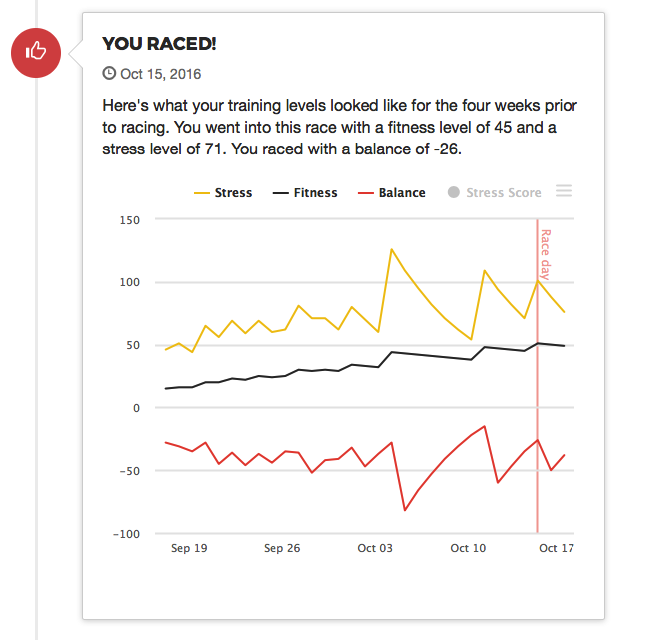Why do these numbers matter?
Let’s start simple and all agree on one thing: the goal of monitoring your cycling data is to improve future performance. There are many ways to keep tabs on fitness levels, but the majority see power-based training to be the most accurate. This is the sole focus of WattsBoard.
Fitness, Stress and Balance are three key measures in evaluating cycling performance. These numbers are all based on the stress level of rides over previous weeks, and as you may already know, the stress level of a ride is based on your power numbers from that ride. The higher your power numbers are (or the longer your ride is), the more stressful the ride will be on your body.
These metrics are based on an impulse-response model which was developed by Dr Eric Banister. Dr Andrew Coggan has also developed these models further with a specific focus on cycling.
Each of these three metrics has an effect on the others, and monitoring the levels over time can help lead to improved performance by optimizing your planning for a race or an ‘A’ effort.
A high-level introduction
At the most basic level, Fitness is self-explanatory and the majority of riders have an understanding of this concept. Fitness is a long-term concept - it's like your savings account. Build it up so you can use it when you need it. You can think of it as being in shape. By default, this number is based on your rides within the past 42 days. The higher the number is, the more fit you are. This can lead to better performance. But fitness doesn’t tell the whole story. Everyone knows that if the fittest rider went for a huge ride yesterday, that rider won’t be riding well today.
Stress is based on a similar concept to Fitness, but it’s only focused on your rides over the past seven days. Stress is acute. A few hard days in a row and your Stress number is going to increase very quickly. Stress is that tired feeling in your legs the day after a hard ride. It’s the reason why that fit rider isn’t riding fast today. The higher this number is, the lower your performance may be (relative to your Fitness number).
Balance is the final result. It's the difference between Fitness and Stress (for example, with a Fitness level of 100 and a Stress level of 60, your Balance will be +40). You can look at balance as how fresh you are. Typically, riders are feeling the freshest and have their best performances when their Balance is positive (though every rider is different and some perform best with a slightly negative balance).
Don't skip past that last sentence too fast: everyone responds to certain levels differently. What's important is that while you're training, you monitor and consider how your body responds to different levels. Keep track of how you raced when you were riding with a negative balance. Keep track of how you raced when you were riding with a positive balance. Are you super fast when your Balance is +10? Then try to plan your training so that your Balance is +10 on the day of your next big race. After the race, recap and iterate for the next race.
Don't know what levels you perform best at? Start a training journal and write it down. WattsBoard allows you to tag your races or 'A' efforts (actually you can tag whatever you want). On the Power History page, you'll have a running log of each race, along with relevant performance levels. This should come in handy down the road when you want to look back at specific races. Did you perform well at Tulsa Tough last year? Well, what did your performance levels look like? You can tweak your training from there. Check out my Power History here.
With each metric described alone, it may seem simple to understand the concepts. The tricky part is how you manage the relationship between them. For example, if Balance is the result of your Fitness and Stress levels, then that means the more fit you are, the more stress you can handle while still feeling fresh. A Stress level of 60 may be huge when you first start riding, but for a rider with a Fitness level of 110, 60 may feel pretty low.
This also means that as your Fitness increases, it will be harder and harder to continue that increase. A Fitness increase from 50 to 60 requires less weekly stress than a Fitness increase from 100 to 110. (But with more money in the bank at 110, your Balance can go much higher when you start to taper and lower your Stress levels). That's one of the keys to going fast.
There's more to cycling than Fitness, Stress and Balance
It's important to remember that these levels aren't the only element to being fast. Everyone knows that racers who win crits are different than racers who win hilly road races. The performance chart may tell you that you're going to be feeling pretty good at your upcoming race, but it won't tell you if you're going to have an all-time 20 minute power record to break away and win the hilly road race. If you're only focused on shorter sprint intervals in your training, your longer interval power numbers are going to suffer.
So while it's important to make sure that you have the right quantity of training, it's just as important that the quality and type of training you do matches with the type of riding or racing you want to be good at.
(We did't even touch on the mental aspects of training either. To race well, you need to want to race well. Don't let your pursuit of a high Fitness level kill your motivation to train and race. We'll get into that another time.)



Comments